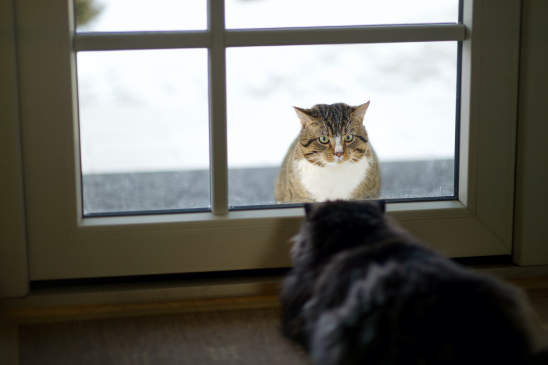If your cat has grown up as an "only child," they may not be too quick to welcome a new feline friend. And, you understand, change can be difficult — especially when that change means splitting snacks, attention, and time on the sunniest windowsills in the the house. Of course, that doesn't mean you have to remain a one-cat household forever. And that also doesn't mean your cat has to hate it! If you're thinking about adopting a furry sibling, these tips and tricks to introducing a second cat into your home can help you do it right.
Match Your Cats
The saying "opposites attract" isn't necessarily true for cats. Especially if you have a senior kitty, bringing home an energetic kitten can stress your older cat out. Try to match the age, personality, and energy level of your cats so they do not clash with one another.
That said, two "opposite" cats can learn to get along. But finding the right match can help ensure a harmonious household (and a few extra hours of sleep for you).

Swap Scents
You can start the introduction process before you even bring the cat home by first letting them get used to each other's scent. "Swap blankets that the cats have slept on so that they can get familiar with each other's scent, as scent is very important to cats," says Jessica Char, a Fear Free Certified animal behavior professional who specializes in cats, and owner of Feline Engineering based in San Jose, California.
Keep Them Separated
Once you're ready to bring home your new cat, it’s important to let your two cats meet each other on their own terms. "Allow the new cat to adjust to their new home first by keeping them in their own separate room until they become familiar with the space," says Char.
Meanwhile, let your current cat have free range of the rest of the house. This helps prevent your current cat from growing territorial and aggressive.
"Before officially introducing the two cats to each other, they both need to feel safe and secure in your home," says Char.
It’s important to let your two cats meet each other on their own terms. "Allow the new cat to adjust to their new home first by keeping them in their own separate room until they become familiar with the space. Before officially introducing the two cats to each other, they both need to feel safe and secure in your home
Explore the “Door” Method
By keeping the new cat in its own room, your two cats can first meet under the door. They may hiss at one another or reach their paws under the door, attempting to swat one another.
Depending on their personalities, this behavior could continue for a while. Give the cats at least a day or two in this setup so they can become aware of each other's presence.
Once you’ve given the door approach some time, look for signs that your cats are ready for the next phase. Your current cat should start ignoring the presence of your new cat, and both cats should start acting more curious than aggressive. In either case, you still need to exercise caution as you proceed.
Feed The Cats At The Same Time (But Separately)
The next step: Try feeding the cats on opposite sides of the door. This helps the cats form a positive association of each other.
Even if your cats are not motivated by food, this strategy can still be effective. Feed them this way for a few days. Once they can eat together happily, your cats may be ready for the next step.
Switch To A Baby Gate
If possible, the next step is to use a tall baby gate or glass door to let the cats "meet" eye to eye for the first time.
"Start doing short visual introductions that include lots of treats, food, and play to create positive associations,” says Char. “Short, frequent interactions (even just seeing each other) over the course of several days are best in the long term — but they have to be positive."
Start doing short visual introductions that include lots of treats, food, and play to create positive associations. Short, frequent interactions (even just seeing each other) over the course of several days are best in the long term — but they have to be positive.
Try Playtime
Once your cats have seen each other, try going into the room and playing with your new cat. In a few minutes, have someone bring your current cat into the room in a very relaxed and casual manner.
Do not hold the cats when they meet each other. Put them on the floor for everyone's safety.
The cats may start hissing and swatting at each other again. If they get too aggressive, try distracting them with a loud noise or spray from a water gun. Guide the cats away from each other and separate them again.
If needed, you can revert back to the door separation. Give it a few days, then attempt to go through the process and introduce the cats again.

Expect It To Take Time
It will likely take a few weeks for your two cats to fully adjust to one another’s presence. Even if they don’t become best friends, they will likely reach a point of tolerance. Just be sure to take things slow and focus on keeping it safe and low-stress.
